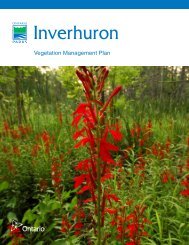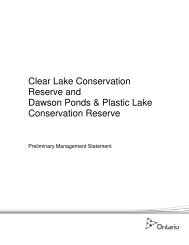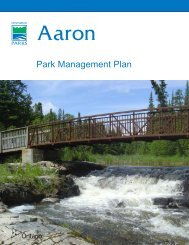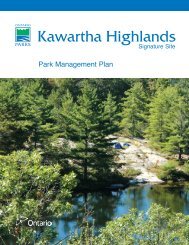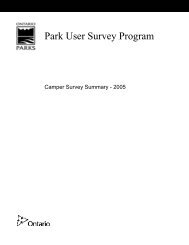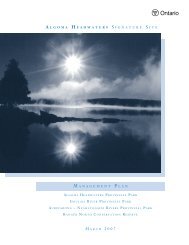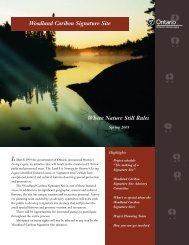Sandbanks Draft Veg Mgmt Plan - Ontario Parks
Sandbanks Draft Veg Mgmt Plan - Ontario Parks
Sandbanks Draft Veg Mgmt Plan - Ontario Parks
You also want an ePaper? Increase the reach of your titles
YUMPU automatically turns print PDFs into web optimized ePapers that Google loves.
IMPLEMENTATION SCHEDULE G – Restoration Implementation <strong>Plan</strong><br />
• A tally of all planted individuals should be conducted by species in the following<br />
categories to determine total mortality of the planted material: healthy, mild damage<br />
(some defoliation), medium damage (dead/broken leader), severe damage (only<br />
epicormic branches), and dead.<br />
• Five plots measuring 10m by 10m should be permanently marked and the coordinates<br />
determined by GPS within each restoration site to monitor the growth and survival of all<br />
planted material. Within these plots:<br />
• Four photographs should be taken from the centre point of the plot looking out in<br />
each of the cardinal directions.<br />
• Heights and diameters should be taken of each tree so that they can be tracked over<br />
time.<br />
• Any new “volunteer” trees or shrubs that were not planted (ie: naturally established)<br />
should be noted as such and measured as above.<br />
• Cover estimates should be made for each woody species within the plot as well as a<br />
total percent cover of all woody species for the entire plot, as this provides an<br />
indication of progress towards canopy closure.<br />
• A complete species list for the plot should be created to measure changes in plant<br />
diversity. These data can be analyzed using an appropriate diversity index.<br />
• One 1m by 1m plot should be located in each of the four corners of the larger plot to<br />
measure the percent cover of all herbaceous and graminoid species. Calculate<br />
importance values for each species to note changes over time<br />
• Additional information should be recorded on water levels, wildlife use, damaging agents<br />
(disease, insects, browse, etc.) and signs of disturbance.<br />
Annotated Resources<br />
Barry, W.J., A.S. Garlo, C.A. Wood. 1996. Duplicating the Mound-and-Pool<br />
Microtopography of Forested Wetlands. Restoration and Management Notes<br />
14:1, 14-21.<br />
• provides construction details for pits and mounds method<br />
Bellemare, J., G. Motzkin, and D.R. Foster. 2002. Legacies of the agricultural past in<br />
the forested present: an assessment of historical land-use effects on rich<br />
mesic forests. Journal of Biogeography 29: 1401 – 1420.<br />
• describes effect of historical uses on soil chemistry, even when forest cover is reestablished<br />
– see fewer nutrient-demanding herbs with more recent disturbance<br />
• forest herbs need to re-establish through seed-dispersal – dispersal method can affect reestablishment<br />
success, along with rates of seed production and establishment requirements<br />
• establishment also depends on distance from primary forest and refugia (hedgerows)<br />
• provides good species lists and seed dispersal classification<br />
McLachlin, S.M. and D.R. Bazely. 2001. Recovery patterns of understorey herbs and<br />
their use as indicators of deciduous forest regeneration. Conservation Biology<br />
15: 98-110.<br />
• describes microsite needs of native understorey herbs<br />
Verheyen, K., O. Honnay, G. Motzkin, M. Hermy, and D.R. Foster. 2003. Response of<br />
forest plant species to land-use change: a life-history trait-based approach.<br />
Journal of Ecology 91: 563-577.<br />
• describes how specific life-history traits of different species affect regeneration<br />
<strong>Sandbanks</strong> <strong>Veg</strong>etation Management <strong>Plan</strong> A-29<br />
<strong>Ontario</strong> <strong>Parks</strong>, SE Zone<br />
2009





